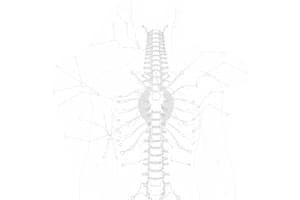Podcast
Questions and Answers
What is the primary function of the Tectospinal Tract in response to visual stimuli?
What is the primary function of the Tectospinal Tract in response to visual stimuli?
- To regulate muscle tone in response to movements of the head
- To receive info from cochlear nuclei
- To control postural movements of the head (correct)
- To maintain the balance of the body
What is the role of the cerebellum in the Vestibulospinal Tracts?
What is the role of the cerebellum in the Vestibulospinal Tracts?
- It has no influence on the Vestibulospinal Tracts
- It provides sensory information to the Vestibulospinal Tracts (correct)
- It is indirectly influenced by the labyrinthine system of the inner ear
- It directly regulates muscle tone in response to movements of the head
What is the origin of the Lateral Vestibulospinal Tract?
What is the origin of the Lateral Vestibulospinal Tract?
- Superior colliculus
- Lateral vestibular nucleus (correct)
- Inferior colliculus
- Medial vestibular nucleus
What is the primary function of the Vestibulospinal Tracts?
What is the primary function of the Vestibulospinal Tracts?
What is the termination point of the Tectospinal Tract?
What is the termination point of the Tectospinal Tract?
What is the role of the labyrinthine system of the inner ear in the Vestibulospinal Tracts?
What is the role of the labyrinthine system of the inner ear in the Vestibulospinal Tracts?
What is the decussation point of the Tectospinal Tract?
What is the decussation point of the Tectospinal Tract?
What is the function of the Lateral Vestibulospinal Tract?
What is the function of the Lateral Vestibulospinal Tract?
How many Vestibulospinal Tracts are there?
How many Vestibulospinal Tracts are there?
What is the origin of the tract that receives info from cochlear nuclei?
What is the origin of the tract that receives info from cochlear nuclei?
Flashcards are hidden until you start studying
Study Notes
Major Motor Tracts of the Spinal Cord
- The motor tracts of the spinal cord relay motor instructions from the frontal lobe of the cerebral cortex and brainstem nuclei to the spinal cord.
- There are two classifications:
- Pyramidal tracts that convey impulses to control skeletal muscles of the limbs and trunk, including the lateral and ventral corticospinal tracts.
- Extrapyramidal tracts that conduct signals regulating subconscious or postural body movements, including rubrospinal, tectospinal, vestibulospinal, and reticulospinal tracts.
Motor Pathways
- Upper motor neurons (UMNs) begin in the cortex and terminate in the brainstem or spinal cord.
- Lower motor neurons (LMNs) begin in the brainstem or spinal cord and innervate muscles.
- Corticobulbar (Corticonuclear) tract terminates in the brainstem, synapsing on cranial nerve nuclei.
- Corticospinal tract terminates in the spinal cord, synapsing with motor neurons in the ventral horn of the spinal cord.
Corticospinal Tract
- Transmits voluntary motor (conscious) control of skeletal muscles of the body.
- Pathway:
- Neuron 1: Upper Motor neuron (UMN) originates in primary motor cortex of frontal lobe (pre-central gyrus).
- Neuron 2: Lower Motor neuron (LMN) cell body originates in anterior grey horn of spinal cord, exits cord via ventral root of spinal nerve, and travels via peripheral spinal nerve to target skeletal muscle.
Clinical Correlate: Lesions of Motor Neurons
- Upper motor neuron (UMN) lesions:
- Spastic paralysis (no control).
- Muscle tone changes: increased (abnormal muscle tightness).
- Reflexes issues: increased (hyper-reflexia).
- Lower motor neuron (LMN) lesions:
- Flaccid paralysis (loss of signal).
- Muscle tone changes: decreased (loss of signal).
- Reflexes issues: decreased (hypo-reflexia).
- Atrophy (muscle wasting).
- Fasciculations (muscle twitching).
Extrapyramidal Tracts
- Conduct signals regulating subconscious or postural body movements.
- Tracts involved:
- Rubrospinal tract: originates from the red nucleus of the midbrain, involved in mediation of involuntary movement, muscle tone, posture, and skeletal muscle control.
- Tectospinal tract: originates from the superior colliculus of midbrain, involved in postural movements of head in response to visual and auditory stimuli.
- Vestibulospinal tracts:
- Lateral vestibulospinal tract: begins at the lateral vestibular nucleus, regulates muscle tone in response to movements of the head, and plays a role in balance and equilibrium.
- Medial vestibulospinal tract: indirectly influenced by the cerebellum and labyrinthine system of inner ear, maintains antigravity muscle tone in response to the head being tilted to one side.
Function of Extrapyramidal Tracts
- Maintaining posture and regulating involuntary motor functions.
- Providing postural tone adjustment, predisposing tonic attitudes for involuntary movements, and controlling automatic modifications of tone and movements.
- Inhibiting involuntary movements (hyperkinesias).
Studying That Suits You
Use AI to generate personalized quizzes and flashcards to suit your learning preferences.



